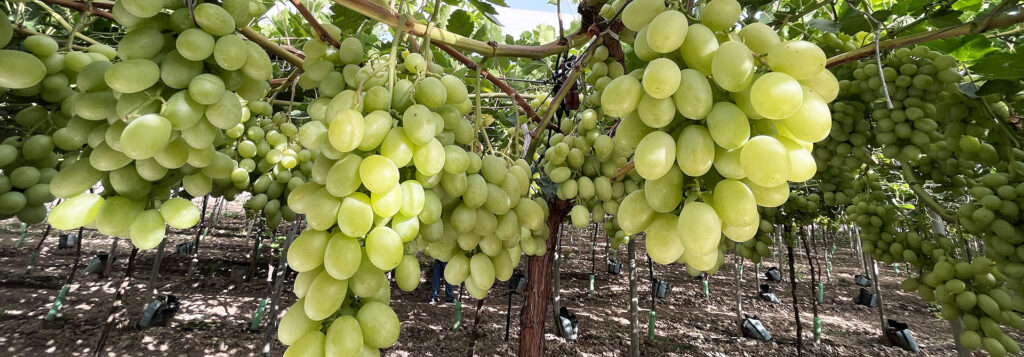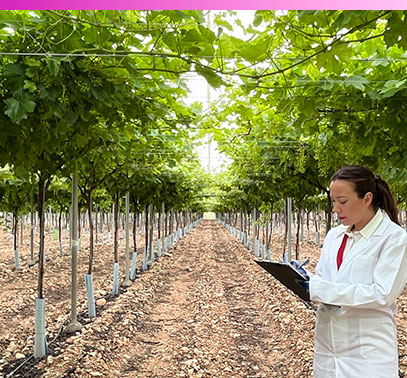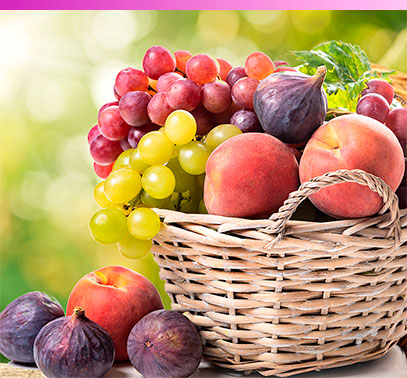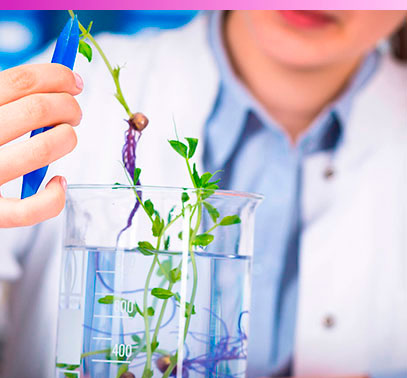
How much water does table grape need? All you need to know
Adequate irrigation is crucial for grapevine cultivation. Water requirements vary according to the grape variety and soil water-holding capacity. Water stress affects vine growth and development, while excessive water can delay maturation. Different irrigation systems, such as flood irrigation and drip irrigation, are used in viticulture. FAO proposes a method to calculate water requirements, considering climatic variables and crop coefficients. Raimsa Grapes uses advanced technologies to optimize irrigation in their vineyards in Alicante’s Grape Valley.
Importance of Adequate Irrigation for Grapevines
Proper irrigation is fundamental for the healthy cultivation of grapevines. Supplying the right amount of water at each stage of plant growth and development is essential to ensure optimal grape production and quality. In this section, we will address two key aspects related to the importance of irrigation in viticulture: the influence of grape variety on water requirements and the impact of soil water-holding capacity on irrigation
Grape Variety and its Influence on Water Requirements
Each grape variety has specific water requirements. Some varieties may be more drought-resistant, while others may require more abundant water for their proper development. Factors such as berry size, plant structure, and sun exposure can influence the water needs of each variety.
Understanding the peculiarities of each grape variety cultivated in a vineyard allows adjusting irrigation accordingly. This will ensure that the appropriate amount of water is provided to meet the specific needs of each variety and maximize its performance.
Soil Water-Holding Capacity and its Impact on Irrigation
Soil water-holding capacity plays a crucial role in vine irrigation. This factor refers to the soil’s ability to retain water and gradually provide it to the plant roots. Soils with high water-holding capacity can store more moisture and release it more slowly, which can affect irrigation requirements. It is essential to know the characteristics of the soil in which the vines are cultivated, including its water-holding capacity. This allows determining the frequency and proper amount of water necessary to maintain an optimal water balance in the vine. Adequate irrigation, considering the soil’s water-holding capacity, will ensure efficient plant nutrition and prevent both water stress and excess that could negatively affect grape quality and yield.
Effects of Water Stress on Grapevines
Introduction: Water stress is a determining factor in vine development and can have significant consequences on growth and production. The following will detail the growth stages affected by water stress, as well as its consequences on grape development.
Growth Stages Affected by Water Stress
Water stress can impact different key stages in the vegetative cycle of the vine. During bud break, a water deficit can hinder the proper formation of new shoots, affecting their development and resulting in irregular budding. In the flowering stage, water deficiency can negatively influence flower fertilization, reducing the number of clusters and affecting future grape production. Additionally, water stress during the veraison phase, a crucial moment for grape development and ripeness, can delay maturation and affect the final fruit quality.
Consequences of Water Stress on Grape Development
Prolonged or severe water stress can have various consequences on grape development. Water scarcity limits the vine’s ability to carry out photosynthesis efficiently, leading to reduced sugar production and, consequently, a decrease in fruit quality. Additionally, water shortage can affect foliage development, reducing the photosynthetic surface area, and, as a result, decreasing the plant’s ability to store nutrients and energy. This can influence the vine’s resistance to diseases and its ability to survive adverse conditions.
In summary, water stress in the vine can compromise its growth, development, and production. It is essential to establish adequate irrigation that ensures the necessary water supply for each stage of the vegetative cycle, thus obtaining quality grapes and optimizing viticultural production.
- • Water stress can affect irregular budding in the vine.
- • Water deficiency during flowering can reduce the number of clusters and affect grape production.
- • Water stress during veraison can delay grape maturation and affect its quality.
- • Water scarcity reduces the vine’s ability to perform photosynthesis efficiently, leading to reduced sugar production.
- • Water stress can affect foliage development, reducing the capacity to store nutrients and energy.
- • Establishing adequate irrigation is key to ensuring optimal vine development and obtaining quality grapes.
Effects of Excessive Water on Grapevines
Excessive water can have negative consequences on grapevine cultivation, affecting its development and quality. Below are two main effects of excessive water on grapevines:
Lack of Oxygen and its Consequences
When grapevines are exposed to excessive water, the soil becomes saturated, and the available oxygen for the roots reduces. This lack of oxygen can lead to root asphyxiation and affect the plant’s ability to absorb nutrients. Moreover, oxygen deficiency in the soil can favor the development of root diseases and reduce the vine’s resistance to pathogens.
Delayed Table Grape Ripening due to Excessive Water
Excessive water in grapevines can delay the ripening process of the grapes. Prolonged moisture extends the growth period and delays cluster ripening. This can negatively impact grape quality, as it affects sugar concentration and aromatic compounds. Additionally, delayed ripening can increase the risk of fungal diseases and limit the possibility of harvesting the grapes at the optimal maturity stage.
Irrigation Systems Used in Viticulture
Irrigation plays a fundamental role in viticulture, as it allows providing the right amount of water to the vines for their optimal development. Over time, different irrigation systems have been developed to meet grape water needs. Below are three of the most commonly used systems in viticulture:
Flood Irrigation and its Application
Flood irrigation involves flooding the soil around the grapevines to provide water evenly. This system is particularly useful in light and permeable soils, where water quickly infiltrates. It is mainly used in the early stages of vine development to ensure proper root establishment and promote vigorous growth. However, care must be taken with excessive water that could lead to waterlogging, negatively affecting roots and grape development.
High-Frequency Drip Irrigation and its Advantages
High-frequency drip irrigation consists of providing small amounts of water frequently and locally around the vine’s root zone. This system has several advantages, including water use efficiency as it minimizes losses due to evaporation, and the possibility to manage each plant or vineyard sector individually based on their specific water needs. Furthermore, it helps prevent water stress at critical moments, such as flowering and grape set, thus favoring proper cluster development.
Drip Irrigation and its Benefits
Drip irrigation is one of the most efficient and precise systems used in viticulture and is the system used throughout RAIMSA Grapes’ farms. It involves applying water directly to the vine’s root zone through small irrigation devices called drippers. This system allows supplying controlled amounts of water uniformly, minimizing losses due to evaporation or surface runoff. Additionally, drip irrigation promotes better utilization of soil nutrients as it avoids leaching and allows for precise application of fertilizers.
Calculation of Grapevine Water Requirements
FAO’s Proposed Method and Key Variables
The calculation of grapevine water requirements is based on a method proposed by the FAO. This method takes into account different key variables to determine the amount of water that grapevines require at each stage of their vegetative cycle. Some of these variables include soil type, climatic conditions, evapotranspiration, and the cultivated grape variety.
Soil Type
The soil’s water-holding capacity is a determining factor in the calculation of grapevine water requirements. Soils with higher water-holding capacity allow grapevines to access moisture more efficiently, reducing the need for additional irrigation.
Climatic Conditions
Climatic conditions play a fundamental role in calculating grapevine water requirements. Temperature, relative humidity, and solar radiation affect the rate of evapotranspiration of the plant, i.e., the amount of water lost through transpiration and soil evaporation. These climatic data are used alongside other parameters to determine the amount of water that grapevines need at any given time.
Evapotranspiration
Evapotranspiration is a key indicator in the calculation of grapevine water needs. It refers to the amount of water that the plant loses through leaf transpiration and soil evaporation. Different methods and formulas are used to estimate evapotranspiration based on various climatic and crop-related variables.
Crop Coefficients and their Relevance in Calculating Water Requirements
Crop coefficients are values used in calculating grapevine water requirements. These coefficients represent the relationship between crop evapotranspiration and reference evapotranspiration, which is the amount of water that a reference crop needs under optimal conditions. Crop coefficients vary throughout the grapevine’s vegetative cycle and are adjusted based on factors such as phenological stage and plant development status.
Phenological Stage
The phenological stage of the grapevine is a determining factor in calculating water requirements. At each stage, the plant has different water requirements due to the growth and developmental processes it undergoes. For example, during bud break, the grapevine requires more water for proper growth, while during maturity, less water is needed to avoid diluting the grape components.
Plant Development Status
The grapevine’s developmental stage also influences water requirements. As the plant grows and develops, its water requirements change. During the vegetative growth stage, the grapevine needs more water to promote leaf and stem development, while during maturity, less water is required to encourage sugar concentration in the grapes.
- • Calculation of water needs based on key variables proposed by FAO.
- • Influence of soil type on grapevine water requirements.
- • Role of climatic conditions in calculating water needs.
- • Estimation of evapotranspiration as an indicator of grapevine water requirements.
- • Utilization of crop coefficients to adjust water needs based on phenological stage and plant development status.
Technological Innovations in Irrigation Monitoring
Efficient irrigation management in viticulture has experienced significant advances thanks to technological innovations. In this regard, at RAIMSA Grapes, we aim to become a reference by using cutting-edge technologies to optimize irrigation in our vineyards.
RAIMSA Grapes Company and its Use of Cutting-Edge Technologies
RAIMSA Grapes is at the forefront of the viticulture industry revolution by implementing the Internet of Things (IoT), big data, and artificial intelligence in irrigation monitoring. Through sensors located in the soil of the vineyards and connected devices, precise information on the water needs of the grapevines in real-time can be collected. This enables more precise management and efficient use of water resources.
Continuous monitoring through sensors allows the detection of soil moisture content, evaporation, and other key factors to establish optimal irrigation patterns. Additionally, RAIMSA Grapes employs advanced analytical systems that process large volumes of data to offer recommendations based on artificial intelligence.
Application of the Internet of Things, Big Data, and Artificial Intelligence
The Internet of Things (IoT) has expanded possibilities for irrigation monitoring and control, enabling remote and real-time supervision. IoT sensors provide detailed information about soil moisture, temperature, and other parameters, allowing precise and efficient irrigation management.
The use of big data in irrigation monitoring involves processing and analyzing large amounts of information to identify patterns and establish correlations. This facilitates well-informed decision-making and the implementation of strategies tailored to the specific needs of each vineyard.
Artificial intelligence (AI) complements these technologies by using advanced algorithms to predict and automatically adapt irrigation based on environmental conditions and the vine’s state. In this way, water use is optimized without compromising crop quality or yield.
- • Customized real-time data-based irrigation solutions.
- • Remote monitoring and control of irrigation through IoT sensors.
- • Big data analysis to identify patterns and correlations.
- • Artificial intelligence for adapting irrigation according to specific conditions.
Through these technological innovations in irrigation monitoring, grape producers can maximize water use efficiency, reduce costs, and minimize environmental impact. These solutions represent a step forward in the viticulture sector, allowing for more precise and sustainable management of water resources in 21st-century vineyards.
Future Perspectives in Irrigation Management in Viticulture
Irrigation management in viticulture is continuously evolving, and interesting perspectives are emerging to further optimize this process. As technology advances, new opportunities arise to improve efficiency and sustainability in vineyard irrigation.
One of the main future trends is the increasingly widespread use of sensors and advanced monitoring technologies. These devices allow real-time data on grapevine water needs, as well as soil and environmental conditions, to be obtained. The collected information can be analyzed and used to adjust irrigation precisely and efficiently.
Another interesting perspective is the application of precision irrigation techniques. These techniques involve tailoring irrigation to the specific needs of each plant or even each zone within the vineyard. By segmenting irrigation, water use can be maximized, avoiding wastage, and reducing the risks associated with over or under-irrigation.
Additionally, smart irrigation systems, which combine automation with real-time data analysis, are expected to play a fundamental role in the future of irrigation management in viticulture. These systems allow continuous monitoring and precise control of irrigation, adjusting dosages and application times according to the vine’s specific growth stage.
Emerging Technologies in Irrigation Management
On the horizon of future perspectives, the potential of emerging technologies such as artificial intelligence and machine learning is observed. These tools could allow for more precise and real-time analysis of the data collected by sensors, facilitating decision-making and optimizing irrigation management more effectively.
Simultaneously, the application of the Internet of Things (IoT) in viticulture also promises to contribute to more efficient irrigation management. Connecting devices and sensors used in irrigation monitoring to centralized control systems can streamline and simplify the management process, allowing for greater automation and optimization.
Commitment to Sustainability
Regarding sustainability perspectives, it is expected that irrigation management in viticulture will increasingly focus on reducing water consumption and preserving water resources. This implies the development and implementation of techniques and systems that minimize water loss, such as subterranean drip irrigation, and promote responsible use of this essential resource.
More info here
Here are some scientific sources that could have been used to support the previous article on vine irrigation and its impact on table grape cultivation:
“Effect of Water Stress on Grapevine Growth, Yield, and Fruit Composition” – Revista Brasileira de Fruticultura
“Irrigation Management of Grapevines” – University of California, Agriculture and Natural Resources
“Soil Water Management in Vineyards” – Food and Agriculture Organization of the United Nations (FAO)
“Effect of Soil Water Status on Grapevine Growth, Yield, and Composition” – Journal of the American Society for Horticultural Science
“The Influence of Water Supply on Grapevine Growth, Development, and Fruit Quality: A Review” – American Journal of Enology and Viticulture
“The Role of Soil Water Availability in Shaping Grapevine Shoot to Fruit Ratio” – Frontiers in Plant Science
“Effects of Water Stress on Grapevines: Root Physiology and Mycorrhizal Associations” – Journal of Plant Physiology
“Water Use Efficiency of Vineyards: A Review” – Australian Journal of Grape and Wine Research
“Advances in Irrigation Management of Grapevines” – OENO One: Journal International des Sciences de la Vigne et du Vin
Is always advisable to consult reliable and up-to-date scientific sources for accurate information on any topic related to viticulture and grape cultivation.



